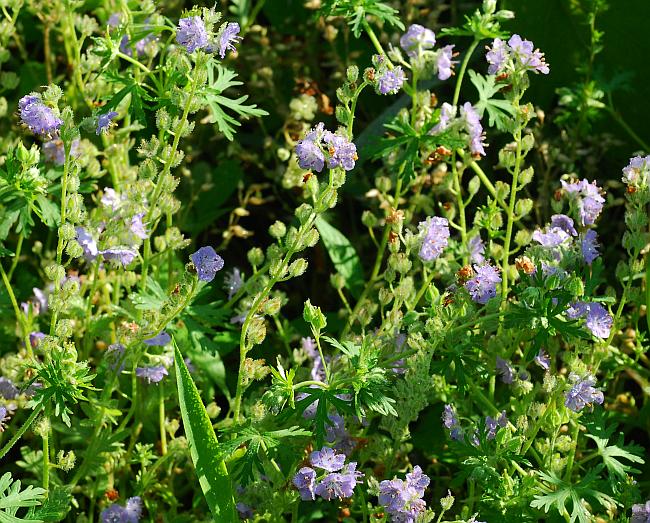Phacelia hirsuta Nutt.
Fuzzy Phacelia

Native
CC = 4
CW = 5
MOC = 30
© SRTurner
Phacelia hirsuta Nutt.Fuzzy Phacelia | |
 |
Native CC = 4 CW = 5 MOC = 30 |
© SRTurner |
|
Family - Hydrophyllaceae Habit - Annual forb, relatively slender, from taproot. Stems - Ascending to erect from a sometimes spreading base, to 45 cm, unbranched to several-branched at the base and above, densely pubescent with stiff, spreading, nonglandular hairs, also with moderate to dense, fine, somewhat tangled, nonglandular hairs toward the tip.
Leaves - Alternate; basal leaves usually withered at flowering. Basal leaves with the blade 1-3 cm long, elliptic to oblong in outline, pinnately compound or deeply lobed with 5-9 lobes, these entire or occasionally with 1 or 2 lobes or coarse teeth, the leaflets or lobes sharply to bluntly pointed or rounded at the tips, the surfaces moderately to densely pubescent with more or less appressed, stiff hairs. Stem leaves short-petiolate to sessile and usually clasping, the blade 0.8-5.0 cm long, progressively reduced toward the stem tip, the uppermost leaf blades usually 5 or 7-lobed, the leaflets or lobes bluntly to sharply pointed at the tips, the terminal lobe of at least the uppermost leaf truncate to somewhat angled or tapered at the base, the pubescence similar to that of the basal leaves.
Inflorescence - Terminal indeterminate scorpioid cymes with 8-30 flowers, the axis and flower stalks pubescent with dense, short, ascending to appressed hairs and moderate to dense, longer, stiff, spreading hairs, the stalks to 1 cm long, ascending to spreading at fruiting.
Flowers - Calyces 4-9 mm long, persistent in fruit, the lobes pubescent with longer and shorter hairs. Corollas 5-8 mm long, 1.1 cm broad, broadly bell-shaped, 5-lobed, lavender to purple, often with a pale lower portion and sometimes also darker-spotted, the margins entire or minutely and inconspicuously toothed or scalloped, the outer surface finely hairy, especially along the midvein and toward the tip. Stamens slightly exserted, alternating with corolla lobes, adnate at base of corolla tube, the filaments 4-6 mm long, densely hairy for most of their length. Ovary hirsute(at least at apex), superior, with mostly 8 ovules. Style branched to less than or about the midpoint.
Fruits - Capsules 3-4 mm long, mostly 6-8-seeded. Seeds 1.5-2.0 mm long, ovoid-angled, finely ridged and/or pitted, dark brown.
Flowering - April - June. Habitat - Bottomland and mesic forests, streambanks, fens, bases and ledges of bluffs, upland prairies, sand prairies, glades, pastures, railroads, roadsides, open disturbed areas. Origin - Native to the U.S. Lookalikes - Other species of Phacelia, especially P. gilioides. Other info. - This little plant is found in Missouri mostly in southern and southwestern counties. Beyond Missouri its range extends to only a few other states, mostly to the south and west. It is reasonably easy to identify by its pale purple flowers borne on inflorescences which are coiled when young. Differentiation from the closely-related P. gilioides can be problematic. That species normally has more pronounced toothing along the corolla margins, whereas P. hirsuta corollas are entire or nearly so. These two species can cross, further muddying the picture. Photographs taken in the Hercules Glade Wilderness, Mark Twain National Forest, Taney County, MO., 4-28-00 (DETenaglia); also in Lake Ouachita State Park, Garland County, AR, 5-5-2015, and near Poison Hollow, Howell County, MO, 5-14-2019 (SRTurner). |